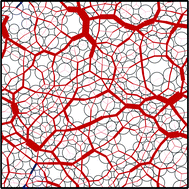Extracting vibrational modes from fluctuations: a pedagogical discussion
Abstract
The study of the jamming transition of granular and colloidal systems, has lead to a proliferation of theoretical and numerical results formulated in the language of the eigenspectrum of the dynamical matrix for these disordered systems. Only recently however, have these modes been accessed experimentally in colloidal and granular media, by computing the eigenmodes of the covariance matrix of the particle positions. At the same time, new conceptual and methodological questions regarding the interpretation of these results have appeared. In the present paper, we first give an overview of the theoretical framework which is appropriate to interpret the eigenmodes and eigenvalues of the correlation matrix in terms of the vibrational properties of these systems. We then illustrate several aspects of the statistical and data analysis techniques necessary to extract reliable results from


 Please wait while we load your content...
Please wait while we load your content...